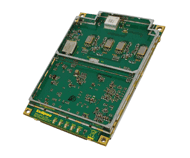 Patrick Fenton, Vice President and Chief Technology Officer, NovAtel, Inc.
Patrick Fenton, Vice President and Chief Technology Officer, NovAtel, Inc.In the RF (radio frequency) spectrum between 3 kHz and 300 GHz, national and international regulatory agencies have sliced and diced the available frequencies into a crazy quilt of allocations for particular uses. GNSS systems, for example, provide positioning, navigation, and timing services in scattered portions of the L-band between 1170 and 1610 MHz.
In the RF (radio frequency) spectrum between 3 kHz and 300 GHz, national and international regulatory agencies have sliced and diced the available frequencies into a crazy quilt of allocations for particular uses. GNSS systems, for example, provide positioning, navigation, and timing services in scattered portions of the L-band between 1170 and 1610 MHz.
But while agencies may promulgate rules concerning their use, radio waves also obey the laws of physics. And their effects do not necessarily stay within the neat confines suggested by RF spectrum wall charts.
One final data point: demand for spectrum is growing.
In the United States, for instance, an initiative by the Obama administration and Federal Communications Commission (FCC) seeks to turn 500 megahertz of spectrum over to broadband services in the course of the next few years.
ABOUT LIGHTSQUARED
Recently, the FCC granted a company named LightSquared Subsidiary LLC the exclusive right to provide so-called Fourth-Generation/Long Term Evolution (4G/LTE) broadband mobile communications services in a band ranging from 1525 to 1559 MHz. This band has a long-standing designation for space-to-earth links for mobile satellite services, but LightSquared obtained a broad waiver to build a dense network of high-power ground transmitters known as ancillary terrestrial components or ATCs.
Because this swath of spectrum borders the lower end of the GNSS L1 band, where civil and military GPS signals now operate, the FCC has established a working group led by LightSquared to investigate whether the ATC transmissions might interfere with GPS.
Pat Fenton, vice-president and chief technology officer for Novatel, Inc., has more than a passing interest in such matters. As a pioneer in the GNSS field — with nearly three decades of involvement with GNSS receiver engineering — Fenton was named to a Technical Working Group established as part of the LightSquared investigation.
EXPERT ADVICE
Fenton considers the LightSquared issue, along with plans to introduce an aeronautical mobile (R) service — AM(R)S — in the 960-1162 MHz band just below L5, as the latest concerns that GNSS engineers, receiver manufacturers, service providers, and users face.
We asked Fenton to comment on a range of issues relating to spectrum allocation, interference, and RF compatibility.
IGM: Recent research has suggested that a general rise in the RF noise floor is occurring as additional GNSS systems and signals — some with higher power levels than legacy GPS signals — come on line, potentially causing problems for receiver signal processing. What are your thoughts about that?
FENTON: As more satellites transmit on the same frequency with CDMA (code division multiple access) ranging signals, a corresponding increase in the noise floor results. To counter this effect, the newer generation GNSS signal designs have longer length PRN (pseudorandom noise) code sequences that allow higher digital processing gains and narrower bandwidth signal processing.
IGM: Do GNSS services in general need more frequency allocations?
FENTON: Not necessarily. The original allocated frequencies adjacent to GPS were low-power satellite broadcasts: GLONASS on the high side and L-band satellite communication downlinks on the low side. In this situation both services can co-exist quite nicely.
IGM: Does the spread spectrum aspect of GNSS signals require special consideration to be given to them compared to allocations for other types of telecom services?
FENTON: The biggest issue with today’s GNSS spread-spectrum signals is their low signal power level — a level so low that the GNSS receiver designs require enormous amounts of amplification (gain) in their radio circuitry. With high levels of gain, however, the receivers become sensitive not only to GNSS signals but also to broadcasts in adjacent frequencies. This situation is analogous to trying to listen to somebody whispering from across the room while a wild party is going on in an apartment next door. The typical solution to this problem is to add more filtering — in our analogy, to build thicker walls for the apartment. However, adding more filtering also increases the size, cost, and power consumption. In some situations, it’s not even possible.
IGM: What factors determine the amount of spectral separation that GNSS signals need?
FENTON: The primary factors are: Signal power differential, frequency separation, and RF filter cost and size. To accommodate the LightSquared GPS situation, where there is a large power discrepancy and little frequency separation, then the required RF filtering may be large and expensive. If the change of filter design is not possible, for example with the large number of existing fielded units, then a power differential and frequency separation must be chosen that are compatible with legacy filter designs.
IGM: Some GNSS experts have suggested that the kind of RF effects produced by LightSquared transmissions could have greater negative consequences for wideband, higher-precision receivers than on those that track the L1 narrowband portion of GNSS signals. Thoughts?
FENTON: True statement. Narrower band GNSS receivers have two advantages in such situations. The first is that their narrow band, by definition, will be further away from transmissions in an adjacent portion of the radio spectrum than a GNSS receiver that has a wider bandwidth. The second advantage is the fact that narrowband filters require fewer poles in their designs and can be designed with much steeper (closer to “brick wall”) filters than wide-band receivers.




